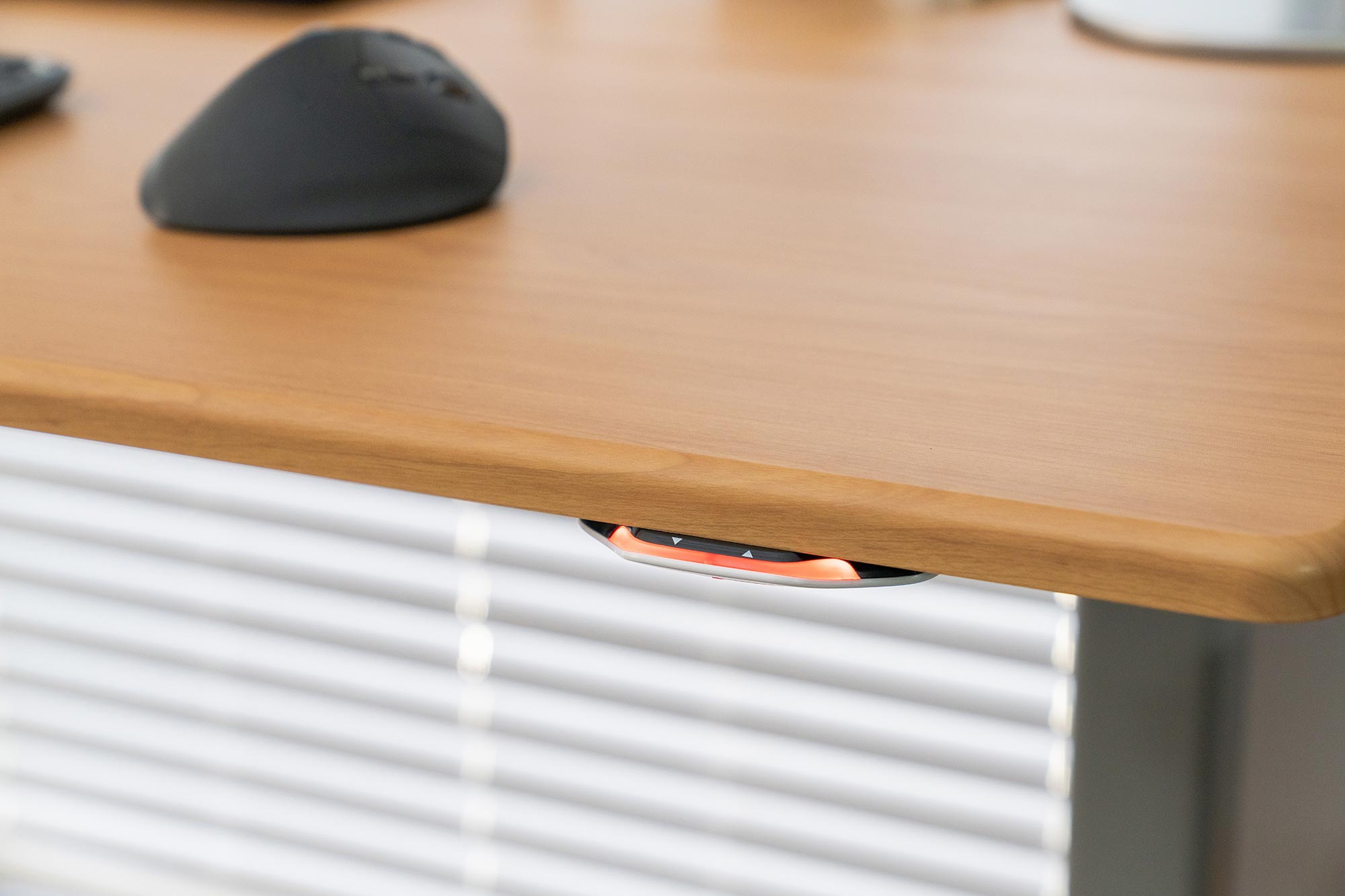Inline Brushless DC Motors in Standing Desks

We’ve come a long way from the original hand crank standing desk. Features like dual synchronized motors, collision and tilt detection, and more recently Bluetooth sync and smartphone apps, have become standard features of premium-grade standing desks such as those manufactured by iMovR.
The development of inline brushless DC motor linear actuators (i.e. the lifting columns of a standing desk) is an exciting new alternative to the traditional, brushed-motor lifting leg designs you'll find on virtually all other electric height-adjustable desks in the market today.
This seemingly simple innovation of removing the commutator brushes from the motors has already set the standing desk industry on its ear because it creates a new price/performance tier in between commodity-grade and premium-grade standing desks. And that’s a huge win for consumers who are shopping for the best desk for the money.
Key Technical Differences
Brushed Motors
Brushed motors use carbon commutator brushes to deliver electricity to internal electromagnets.
- Require simple controller circuitry so are easier and cheaper to manufacture
- Produce good torque at low speeds, but reduced torque at high speeds
- Tendency for brushes to wear down over time, which can lead to premature motor failure
- Electrical arcing in the brushes generates electrical noise that can interfere with smooth motor control and anti-collision detection
Brushless Motors
Brushless motors deliver power through external electromagnets.
- Require more sophisticated controller electronics, adding some cost
- Provide consistent, high torque at all speeds
- Have no brush components that can wear down and require replacement
- Because there are fewer parts, they can be built smaller than brushed motors
- Produce virtually no electrical noise
Brushed Motors and Brushless Motors Are Built Entirely Differently
The conventional brushed DC motor uses an internal armature of copper wire coils, which act as a dual-pole electromagnet. A mechanical rotary switch called a commutator continuously flips the polarity of the electric current flowing into the armature. The electromagnet’s poles push and pull against the motor’s outer magnets, creating rotational movement in the motor shaft.
A brushless DC motor is basically flipped inside out, with permanent magnets mounted on the inside and the electromagnets mounted surrounding them. Thus no brushes are required to conduct electricity to internal electromagnet windings. A specialized sensor tracks the rotor position to electronically flip the polarity of the electromagnetic coils and thus create rotational movement of the motor shaft. This method uses fewer components, is more reliable and avoids electrical and audible noise from brush contact “arcing.”
Real-World Implications
Torque
Brushed motors require less sophisticated circuitry for control, so they’re easier and cheaper to manufacture. They have good torque (twisting force on the shaft) at low speeds, but that torque diminishes at higher motor speeds and is harder to keep constant under varying desk loads.
Brushless motors have an easier time maintaining torque at high speeds and thus always maintain a perfectly constant lifting speed (and noise signature) regardless of the load on the desk.
Reliability
With larger brushed motors, such as the kind used in treadmills, there’s an ability to replace worn-down or failed brushes from the outside of the motor; this is in fact a common service call. In a small form-factor application like a standing desk lifting column, there is no such external service access, and so once the brushes need to be replaced the entire lifting column needs to be swapped out, which can be quite a hassle for the user. Given that, reliability of the motor sealed inside the lifting column is paramount.
Brushless motors having no brushes to wear down, and fewer components in general, generally endow them with a much longer useful life and lower cost-of-ownership over time. Their smaller size also allows for thinner legs on the desk and styling that’s more home decor friendly and less industrial looking.
Anti-Collision Detection
Most anti-collision detection circuitry in standing desks uses current overload sensing to detect when the desk may have hit an obstacle like a doorknob or file cabinet (or child). In a brushed motor, the electrical signal back to the controller can be “noisy” due to arcing that occurs as the brushes scrape by the contacts on the armature, making it sometimes less sensitive at detecting collisions or excessive side-loading on the lifting columns.
Brushless motors are able to more accurately and quickly detect a collision because there is significantly less “noise” in the signal.
Cost
There is a wide spectrum of component quality, and therefore cost, when it comes to brushed motors. Very inexpensive, noisy and unreliable motors are routinely used in those super-cheap, commodity-grade standing desks sold by Chinese manufacturers on Amazon, for example. These are notorious for having a short useful life, and regardless of their warranty coverage replacement, is an enormous pain for the user whose desk failed in a transition between sitting and standing height.
There are, however, premium-grade brushed motor lifting columns, typically manufactured in state-of-the-art robotic factories in the USA and Europe, that are still the quietest, most reliable, and overall best linear actuators to be found on a standing desk, but these are of course the most expensive. Such premium actuators can be found on iMovR’s Lander and Lander Lite desk lines, for example, and are still considered the top-performing linear actuators in the industry, bar none.
Until recently, brushless motors did not even exist in a package small and affordable enough to use in a standing desk lifting base application. iMovR is proud to be the first to bring affordable brushless motors to the standing desk market with its new Jaxson line. While Jaxson desks cost slightly more than the most popular commodity-grade, Chinese-made standing desks, they dramatically outperform them in reliability, noise, stability and anti-collision performance, while also incorporating more state-of-the-art features like advanced handsets with Bluetooth and smartphone integration.
What Kinds of Motors Does iMovR Use In Its Standing Desks?
iMovR was a pioneer in incorporating the world’s best brushed motors and linear actuators ever since we introduced the Lander line in 2018. With the launch of the Jaxson line in 2022, we were the first to introduce standing desks built with brushless motors to the online shopper.
One of the reasons that the Lander Desk continues to win the #1 rating for standing desk quality year after year is that it is built using the very best brushed motor and linear actuator technology in the world, robotically built right here in the USA by Linak. It remains the quietest, most reliable and most stable lifting platform in the industry, with the capability to support 8’-wide desks and even the world’s largest L-shaped and U-shaped desks. Lander models include motors rated to 365 and 540 lb lifting capacity, and have uniform torque and sound signature regardless of the desk load. These characteristics are completely different from cheap actuators manufactured in China, but of course, this is reflected in their cost.
Our Lander Lite was similarly based on Linak technology, only slightly smaller motors with 220 lb. lift capacity. All the other characteristics of these premium motors (torque, noise, reliability, stability) are essentially the same as on the Lander line.
Both the Lander and Lander Lite are entirely manufactured in the USA and are available with over 65 desktop finish options, including our exclusive 3D-laminate and handcrafted solid woods. Both are almost entirely factory pre-assembled and come with 15-year warranties.
The Jaxson line, as well as the new Q Desk, is far more reliable, stable and quiet than commodity-grade standing desks made in China, at only a relatively small premium in price. They are built using inline brushless DC motors, robotically built by LogicData in Europe, and have similar tech-forward features to Linak’s bases in terms of anti-collision detection, Bluetooth and smartphone app control. Jaxson is offered with all our Surf(x) 3D-laminate finishes and features the same 15-year made-in-USA warranty. While Jaxson’s base is quieter and more reliable than most any that are produced in China, it is not as quiet as the Lander or Lander Lite’s Linak bases. Jaxson desks are designed for easy assembly by the user.






